Nib Customizations
When purchasing a pen or nib from us, you can select an applicable nib customization at the time of order. If you would like us to customize a pen or nib you already own, we can do that too! Please see our Request Serivce page for more information.
Introduction to Nib Customizations
Most fountain pens are provided with standard stock nibs ranging in size from Fine to Medium to Broad, with Extra-Fine, Double-Broad, Stub, and Music sizes also common (experienced pen users can check out our tipping sizes page for exact comparisons among the pen lines we carry).
Most stock nibs are designed to give a consistent, unvarying line. But some users, such as artists, calligraphers, or just anyone who wants to add more personality and distinctiveness to their writing, are attracted to fountain pens precisely for the ability to use customized nibs which provide for varying line-widths.
If you are happy with a consistent, unvarying line with your pen, then most likely you will not have any immediate need for a customization. But if you want to achieve line-width variation, you will most likely be considering a customization to Stub, Italic, or Oblique points, and possibly considering adding flex as well. Other customizations can be as simple as a regrind, to make a broader nib more fine, or, less commonly, a retip, to make a finer nib more broad.
In general, the broader the nib point you start from, the more line-width variation you’ll see after customization. These customizations provide for more creativity and individuality in a pen-user’s writing - but they can also be more demanding in terms of the user’s ability to control and handle the pen.
Customizations Guide
The below guide illustrates the differences between a standard, unmodified nib and its customized variations - but we start with a quick look at one of our most popular customizations, the Mottishaw Spencerian.
Spencerian
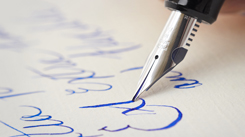 Perhaps our most popular customization, but also one of the most advanced, the Mottishaw Spencerian Customization has gained special attention from being featured in a customer's YouTube video which has now received over twelve million views! The Spencerian starts from a semi-soft 14k nib and adds additional flex and a regrind to needlepoint to create a specialized writing point used for copperplate calligraphy. For more details, visit our special Spencerian page.
Perhaps our most popular customization, but also one of the most advanced, the Mottishaw Spencerian Customization has gained special attention from being featured in a customer's YouTube video which has now received over twelve million views! The Spencerian starts from a semi-soft 14k nib and adds additional flex and a regrind to needlepoint to create a specialized writing point used for copperplate calligraphy. For more details, visit our special Spencerian page.
Double Broad (no customization)
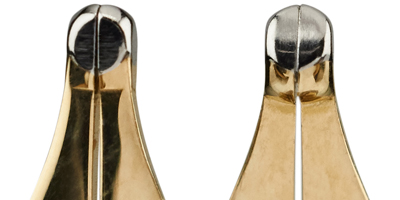
Above is a standard uncustomized Nakaya Double Broad nib. Designed for smooth everyday writing, this nib provides a consistent line width on the page.

![]()

Stub
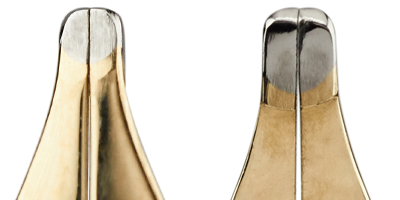
Above is the same size nib after a regrind to Stub. A regrind to Stub is often a good place to start for your first customization. A Stub nib provides broad down-strokes and narrow cross-strokes while writing, and is less position-sensitive on the paper than the crisper and slightly more demanding cursive italic.

![]()

Cursive Italic
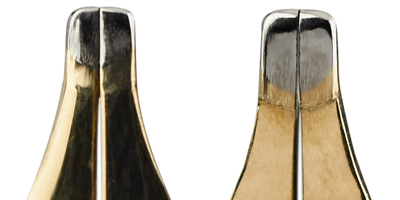
More demanding, but also providing crisper edges and more line-width variation, is the very popular customization to Cursive Italic. This also provides broad down-strokes and narrow cross-strokes, but is also more position-sensitive in terms of how the pen is held and requires more skill on the part of the user. This is a common customization for artists and calligraphers, but is still smooth enough to make for a good everyday writer.

![]()

Formal Italic
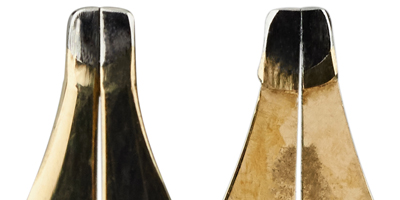
Formal Italic is an even crisper and more demanding customization than either cursive italic or left oblique, and is usually utilized for calligraphy and by the most experienced users. This provides broad down-strokes and narrow cross-strokes, with even crisper corners and edges than a cursive italic - this is an extremely position-sensitive customization.

![]()

Left Oblique
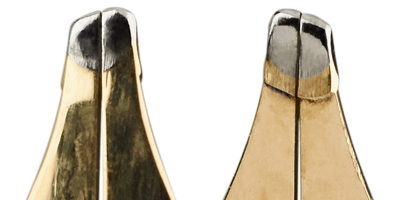
Commonly used for signatures and correspondence, the Left Oblique customization provides broad diagonal strokes and narrow cross-strokes, and like a cursive italic, is more position-sensitive and demanding than a stub. The whole pen must be rotated to the left in order to write smoothly, without skipping. The "Left" in Left Oblique refers to the cut of the nib itself, and does not refer to the handedness of the writer.



Reverse Oblique
(uncommon)
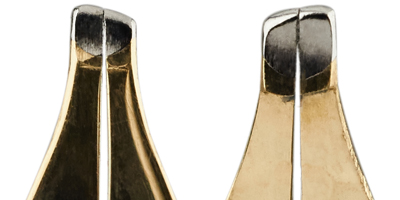
Reverse Oblique is a rare form of customization that provides for the broadest stroke on the reverse diagonal. It is extremely position-sensitive and demanding on the skills of the writer; most pen owners will be much happier with customizations to Left Oblique or Cursive Italic. Some lefties like this one because it requires a clockwise rotation of the nib, making the top surface of the nib more visible to them while they write.

![]()

Flexible Oblique
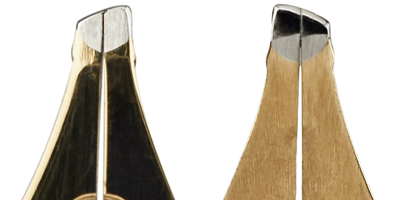
Line-width variation can be also be achieved by adding Flex, which can be done with any size tipping point, though not with every brand of nib - see our FAQ on nibs suitable for flex for more details. Some pens, such as the Namiki Falcon and Metal Falcon, come standard with Soft nibs that are already semi-flexible. Any Nakaya pen can also be fitted with a stock Fine Soft or Soft Medium nib as well. Many experienced users have us add flex to these already semi-flexible nibs to achieve the most flexibility possible.
Flexibility is most often applied to finer nib units, and is also, along with a regrind to needlepoint, part of our popular Mottishaw Spencerian customization - please visit our Spencerian Customization page for more information. But added flex can be challenging for the user, particularly when combined with other regrinds—it’s important to remember that adding flex actually makes a nib less smooth than an unmodified rigid nib. In short, if you’re not sure you need added flex, you’re probably fine without it.



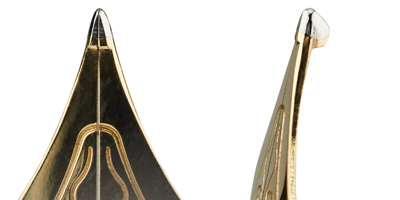
A more exotic regrind is that to Architect’s Point. Named after the style of writing used by Frank Lloyd Wright, this regrind is the opposite of cursive italic, and provides for broad cross-strokes and narrow down-strokes. This also tends to be a particularly useful customization for those practicing Arabic or Hebraic calligraphy.
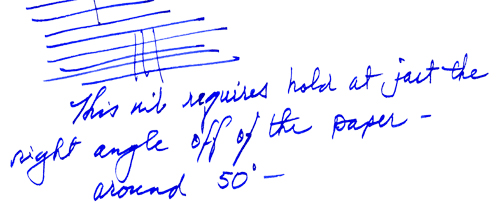
Stock Italics and Obliques
Note that some manufacturers, such as Parker and Pelikan, provide standard nibs labeled as oblique or stub. These stock nibs, however, tend to lack the line-width variation provided in actual customizations. By contrast, Aurora creates Italic and Stub nibs that tend to be very sharp edged, closer to what we would call a Formal Italic – many customers have us use these stock nibs as the basis for a customization to Stub, Cursive Italic or Oblique.
Still not sure if you want a customization, or what kind you need? We’re here to walk you through the process. Feel free to contact us by e-mail at [email protected] or by telephone at (323) 655-2641 from 8:00 am to 5:00 PM Pacific Monday through Friday.
